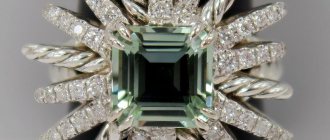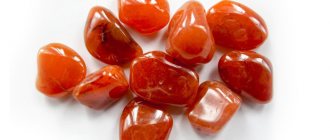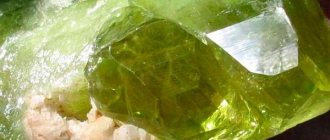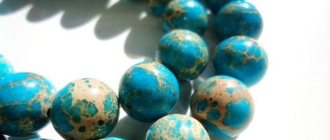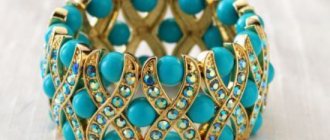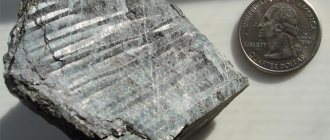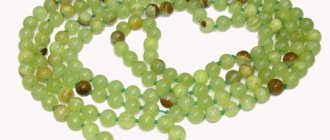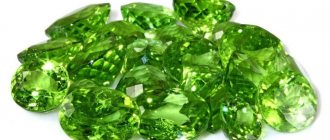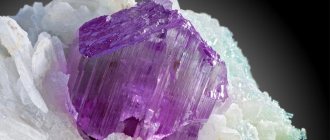Blue agate or sapphirine is a unique variety of quartz. The stripes give the mineral some heavenly airiness and lightness. The stone itself is quite rare in nature and because of this, the demand for it does not fall, but only increases over the years. In addition, the natural gem has healing and magical properties that can positively affect not only the owner’s health, but also his life.
What is sapphirine
The name "sapphirine" often leads to errors. The fact is that the term “sapphirine” refers to:
- To magnesium aluminosilicate - an independent transparent mineral of blue, gray or green color.
- A variety of chalcedony, colored blue or light blue with an eye-shaped wave-like pattern. This mineral is called blue agate. "Sapphirine" in this case is its jewelry trade term, which is used by jewelers, traders and some stone lovers.
This article will talk about sapphirine, a blue agate that is a type of chalcedony. Blue agate is also sometimes called this mineral.
Mineral mining
The gem has been mined for more than tens of thousands of years. The oldest artifact with sapphirine was created in the 5th century BC. e. It was first discovered in Greenland. In the modern world, mineral deposits are found in such countries and regions as:
- Crimea;
- Transbaikalia;
- Armenia;
- India;
- Mongolia;
- Sweden;
- Georgia;
- Mexico;
- Brazil;
- China;
- Ural.
Despite the numerous places of extraction, the mineral is quite rare, since its deposits are limited.
The shape of raw stone is different, but there are always breaks and irregularities. The color is mainly blue, but there is also sapphirine in blue and green shades. Less commonly seen are brown and colorless crystals. The gem can change its shade depending on the lighting. One-of-a-kind specimens that become transparent after processing are mined in Madagascar. The value of Madagascar stones is the highest.
This mineral is similar to another stone - chalcedony. Therefore, many consider sapphirine to be a type of chalcedony. But this opinion is erroneous, as is the fact that the crystal is the “son of sapphire.” It is a completely independent mineral with unique chemical and physical properties.
Story. Origin
The basis of blue agate is quartz, which forms in the voids of volcanic rocks. Water flows through them, enriched with silica, which envelops the voids, and blue agate forms there over time.
This mineral has been known to people for a long time. Archaeologists have discovered it in Neolithic artifacts. Most likely, at that time the stone was used as healing amulets.
The inhabitants of Babylon, Ancient Egypt, and Ancient Greece also valued it for its healing properties. For example, the ancient Romans believed that crushed agate mixed with water helped treat snake bites.
People hoped that this gem would protect them from lightning, hurricanes and other dangers. Sailors wore amulets made from it to protect themselves from violent storms.
For a long time, vessels, seals, and jewelry were made from blue agate. The eyes of statues were made from it in order to scare away dark forces.
The Roman historian Pliny the Elder suggested that the name of the stone was derived from the Achates River, near which the mineral was found. Some believe that it comes from a Greek word meaning “good” or “happy.”
Read also: Scapolite - a stone staff that bestows knowledge
Healing properties
Like many other stones, this mineral has a number of healing properties. Moreover, the spectrum of action on the body is quite wide. Sapphirine exhibits its properties by helping:
- increase confidence;
- fight excess weight;
- in the treatment of skin diseases;
- eliminate irritation and calm the nervous system;
- protect blood vessels and heart;
- reduce the risk of developing diabetes;
- fight insomnia;
- treat joints, throat, respiratory organs;
- improve vision and hearing;
- heal bone fractures.
Description
Blue agate has a layered structure that creates a striped color. The layers are heterogeneous in content, therefore they have different shades of white, blue, and dark blue. Thin strips on the cut of the stone are connected in such a way that they resemble either a cloud, or an eyeball, or openwork lace. The layers are separated from each other by a boundary - clear or blurred.
The intensity of the blue tone depends on the amount of zirconium oxide.
The mineral has a matte sheen and is translucent at the edges. After polishing, blue agate loses its matte shine and becomes glassy.
Because of its blue, white, azure stripes, the mineral is sometimes called the earth's rainbow.
The ABC of vintage jewelry. Crystal Sapphirite and Sapphirine
Pebbles that are unique in their beauty!
Sapphire is an artistic glass that was invented by glassmakers in the city of Gablonz in the mid-19th century. The city belonged to Austria-Hungary, was the center of the region of Northern Bohemia and a concentration of glass masters. Later the city was renamed Jablonec nad Nisou, and in the 20th century it passed into the Czech Republic.
The production of sapphirites did not last long for a number of reasons.
One of them is expensive production. It was multi-stage. It is known that molten gold and sapphire glass were used to make sapphirite.
Later they began to experiment. Instead of sapphire glass, ruby glass began to be used, and as a result, stones with a pink tint began to be obtained, they were called pink sapphirites.
Isn’t it true that the ingredients in the recipe were far from cheap?!
The color and beauty of the crystal depended on the observance of exact proportions, as well as on the sequence of what was poured into what.
The secret, unfortunately, has long been lost. The production of sapphirites began in the Victorian era and ended around 1910, i.e. just at the end of the Edwardian era. Some sources claim that the production of jewelry with these wonderful stones in Northern Bohemia continued until the 30s of the previous century. Old stocks of pebbles in warehouses and workshops were used.
Many truly antique pieces of sapphirite were set into jewelry, i.e. in silver or silver with gilding. On the vintage jewelry market, you can find sapphires in later pieces from the 50s to 70s. It's very simple to explain. The stones were taken out of an old decoration (the metal of which, for example, had become unusable) and inserted into a new one. (Juliana) is in great demand for rare parure with sapphirites. The parures were produced in a small batch with stones from old stock. The cost of this parure starts from several thousand dollars.
Parure with sapphirites from “De Lizza & Elster”, photo from the catalogue.
Absolutely all jewelry with this magnificent stone is highly valued by collectors, but especially jewelry from the Victorian and Edwardian periods.
Sappharine – Art glass or glass crystals (as they are commonly called) were made to imitate earlier sapphirites. They were produced in the 50s-60s in Germany and Northern Bohemia.
Famous companies of the last century used them in their costume jewelry: Weiss, Regency, Florenza, Whiting & Davis, Kramer.
Sapphirines, in comparison with sapphirite, have greater transparency, if I may say “wateriness,” so to speak.
Their multicolor is less pronounced.
But sapphirines are also highly valued by collectors at the moment.
There are a number of countries (for example, in Japan) where these stones are not distinguished by value and they are all called sapphirites.
And not many sellers of vintage and antique jewelry have knowledge about these wonderful stones.
I will share with you, my dear customer, one small trick.
When visiting flea markets and antique stores in other countries, it is very difficult to explain to the seller that you want to buy items with sapphirine.
We remember that not everyone knows about its name, and it is quite difficult to talk about all the unusualness of this stone in a non-native language. Therefore, you just need to have something with such a stone with you. And when you come to make a purchase, you simply take it out and show it, while asking a question in the seller’s language: “Do you have jewelry with the same stone?”
Brooch from my personal collection of the 30s, cabochon-cut sapphire.
I previously blogged about the Peacock Eye crystal.
Physicochemical characteristics
Blue agate is a type of chalcedony, a mineral from the quartz family.
- Chemical formula - SiO2 .
- Color: light blue.
- The gloss is matte (after polishing it is glassy).
- Transparency - opaque, may show through at the edges.
- Hardness - 6,5–7.
- Density - 2.6 g / cm3 .
The bluish tints appear due to zirconium oxide.
The mineral is resistant to acids. May fade when heated. To return the normal color, the stone can be placed in water for several hours.
Read also: Lepidolite - a stone that protects from dangers
Cost of blue agate
The cost of a stone depends on several factors:
- The place where the mineral is mined. Many deposits are located in Brazil and Africa, from where transportation to European countries and Russia is expensive.
- When calculating the cost of the product, the wear and tear of the equipment involved in production is taken into account, as well as the work of all employees at the processing stages.
- The lighter the stone is, the lower its price.
Thus, the average price for an unprocessed stone weighing up to 10 g is 700 rubles, and for a mineral of 30 g you need to pay about 1,500 rubles.
The cost of jewelry with agate is much higher. This is explained by the price for the metal and the jeweler’s work:
- Although stones are most often framed in silver, the cutting and decoration of the jewelry is expensive.
- The processing of the mineral in the form of a cabochon adds value to the product . At the same time, the unique pattern of blue agate and the play of color are emphasized. The price directly depends on the weight.
- The shape of the decoration also plays an important role. A simple pendant will cost less than an exquisite ring or earrings.
Each product is unique, because it is impossible to find 2 stones with the same pattern.
Important! If the jewelry is made to order according to an individual sketch, then you will have to pay several times more.
Application
Due to its high hardness, viscosity, and strength, the gem is used for making:
- pestles, mortars for chemical laboratories;
- prisms for analytical balances;
- watch stones.
Blue agate is also used for artistic carving, and its best examples are used for making jewelry.
Stone cutting art
Various carved items are made from stone: cameos, glyptics, mosaics, figurines, boxes, and items for decorating rooms.
Thin small plates of agate are used to make small closed mirrors, powder compacts, key rings, lighters, and cigarette cases.
Jewelry
Jewelers most often process agate in cabochon form. This mineral is inserted into bracelets, necklaces, rings, and earrings. Many craftsmen make jewelry from this stone with an inconspicuous frame, as they believe that a massive frame will only spoil its wonderful appearance. The color of blue agate does not go well with gold, so it is usually framed in other precious metals.
Talismans and amulets
Amulets and talismans made of blue agate are varied: from a stone in a frame to a simple cut of it on a cord.
The meaning for a person who wants to find a magical assistant in blue agate is the stone itself, and not its shape or frame.
To avoid the initial fear of motherhood and caring for a newborn, pregnant women are recommended to wear an agate amulet (especially a bluestone pendant or beads made from it).
WHAT IS THE MINERAL SAPPHIRE?
Composition and physical characteristics
Experts call sapphirine spinel or kyanite, as well as blue agate.
Sapphirine has a “moiré effect”: this is an effect when light is reflected from the surface and patterns are superimposed on one another.
- The mineral shines like glass, but is opaque. Has faint veining.
- The color of the crystal is a mixture of milky and blue. Formed by zirconium content.
- Sapphirine also contains a large number of different elements - magnesium, sodium, iron, quartz, chalcedony.
- The rock is presented in the form of tabular crystals. They have uneven fractures and a grainy structure.
- The mineral contains some water.
- Sapphirine is absolutely insoluble in acids.
Sapphirine deposits in Yakutia
Some sources say that sapphirine stone is a type of chalcedony. What is wrong: it is an absolutely independent mineral.
How is it formed and mined?
Sapphirine is a rather rare stone. It was first found in Greenland. A scientist from Germany, Strohmeyer, wrote in 1819 that the stone has a sapphire blue hue.
- Crystal deposits have been found in Russia - in Yakutia, Crimea, Transbaikalia, the Urals, and the Kola Peninsula.
- There are natural deposits in Georgia, Armenia, Canada, the southern part of Brazil and Mexico, Uruguay, India, China, Australia, and Sweden.
- Another mineral was found in a country belonging to the European Union - Italy.
- In Mongolia, entire scatterings of stones have been discovered in the Gobi Desert.
- In the USA, in the state of Oregon, deposits of a bluish-silver mineral were found.
We recommend: ALPANIT - Swarovski's crystal fairy tale
Gems with a diameter of up to 4 cm come from reserves of the islands of Madagascar and Sri Lanka.
Transparent sapphirines are considered the most valuable.
Colors and types of cuts
Shades of sapphirine vary from grayish azure and grayish blue to snow-white, cream, and gray-green. The gem also has misty milky impurities and stripes, which gives it grace.
Sapphirine cut
Sapphirine crystal is very easy to process.
Stone can be cut in various ways.
| CABOCHON |
|
| FACET CUT |
|
Medicinal properties
Warning! The information provided in this section of the article has not been scientifically proven, therefore the use of the mineral as the main method of treatment is not acceptable. The use of its medicinal properties is only an addition to the treatment prescribed by the doctor! Moreover, you cannot treat an acute condition by applying a stone; you need to call an ambulance.
The healing power of blue agate is of greatest importance for a person prone to psychological blues. If he looks at this beautiful pebble for 10-15 minutes every day , it will help him get out of a depressed state and return to the joys of life.
It is believed that a stone of the correct shape will bring spiritual harmony to the owner, and an irregular one will encourage action.
Blue agate also affects the emotional mood of a person who cannot feel romantic feelings due to tightness, and he will become more emotional.
This mineral helps improve:
- concentration;
- ability to perceive information;
- analytic skills.
Lithotherapists use it to heal from:
- headaches;
- diseases of the larynx;
- digestive system disorders;
- skin diseases;
- joint diseases.
Blue agate is believed to promote:
- strengthening the immune and skeletal systems;
- acceleration of fracture healing;
- getting rid of sleepwalking and nightmares.
To achieve the greatest effect in treatment, agate jewelry should be worn as close to the sore spot as possible.
INDUSTRIES OF APPLICATION OF SAPPHIRINE
Sapphire is used to decorate furniture, it is used in wall cladding, and the gem is included in tableware.
Depending on the shade, the crystal can treat various diseases.
Checking sapphirine
The brownish crystal has a beneficial effect on people with cardiovascular problems, and the blue mineral has a beneficial effect on the endocrine system.
To increase the effect of the mineral, it should be applied to the diseased area.
Healing and magical properties
Sapphirine treats some diseases:
- relieves dermatological diseases;
- weakens diseases of the larynx;
- improves mental state, relieving sadness and irritability;
- alleviates diabetes;
- relieves insomnia;
- corrects poor vision;
- helps with deafness;
- treats obesity;
- relieves bronchitis and asthma;
- recommended for rheumatic diseases;
- improves the activity of the heart and blood vessels.
Magic properties
The meaning of sapphirine is that the stone is believed to promote mental balance. Those who wear jewelry with the gem supposedly live longer.
Sapphirine can enhance feelings, cool violent jealousy, and avoid ill-considered hasty conclusions.
Who does sapphirine suit according to their zodiac sign?
Sapphirine has a beneficial effect if worn according to the signs of the Zodiac:
- Virgos,
- Aquarius,
- Twins,
- Taurus,
- Capricorns.
Blue agate
Stone talismans are especially recommended by astrologers for the signs of the water element - Pisces, Scorpios, Cancers.
It is not recommended to wear sapphirine amulets for Sagittarius and Aries.
Magic properties
Blue agate is believed to have a variety of magical properties and promotes:
- Demonstration of creativity and inspiration.
In Italy, Renaissance artists wore this stone as a talisman.
- Development of intuition.
- Achieving a high spiritual level.
- Development of eloquence, ability to persuade.
- Achieving emotional balance (a hot-tempered person under the influence of the stone will become more restrained, but someone who wants to open up emotionally will be able to do so).
- Relieving stress, recovering from psychological trauma.
- Self-confidence.
Unbalanced people can restore mental balance by using blue agate during meditation. But some esotericists warn that you should not focus on it for too long, as this can distance you too much from the real world, after which returning to reality will have a depressing effect.
Such gems are used to make talismans and amulets. They improve the atmosphere in the house, prevent conflicts, and protect from evil people.
To increase the positive effects of blue agate magic, the stone should be washed from time to time with cold running water to remove accumulated negative energy.
How sapphirine is mined (video)
https://www.youtube.com/watch?v=IfNHP1JMQ3g
This semi-precious mineral is recommended to be worn by people who are unable to cope with their emotions. It gives its owner peace of mind, emotional stability, and prevents attacks of aggression and psychological breakdowns. This assistant stone helps to realize life’s plans and plans and restores the aura. For women, the mineral helps to conquer members of the opposite sex, relieves melancholy and depression. Products with sapphirine are excellent amulets, giving a feeling of peace and harmony with the outside world. This crystal can be a good talisman for both business and creative people. It helps to raise the creative spirit, adds patience and perseverance, and gives emotional stability. The mineral helps to express your thoughts more clearly, relieves uncertainty and irritability, and helps to improve relationships between loved ones.
Who is suitable according to their zodiac sign?
According to the horoscope, blue agate is suitable mainly for the zodiac signs of the elements of Water and Air, in particular, it has excellent compatibility with people born under the constellations of Gemini, Pisces, Cancer, Aquarius, Libra.
- Gemini will feel the influence of this stone the most. It will open the way to new possibilities by activating intellectual abilities and balancing emotions.
- Pisces patience, self-confidence and respect from others.
- Cancer will protect you from enemies and give you self-confidence.
- Aquarius will also gain confidence in his abilities, his inner life will become more harmonious.
- Libra will feel a talent for communication, and the positive qualities of their character will be fully manifested.
Many astrologers believe that blue agate is perfectly compatible with the zodiac sign Sagittarius . For people born under this constellation, the stone will help build harmonious family relationships and maintain them for many years. This will be facilitated by small products made from this mineral, placed in the living room or bedroom.
It is not recommended to use blue agate as a talisman or amulet for Aries and Sagittarius , as they may show nervousness, non-commitment, and fussiness. These signs are ideal for: amber, spinel, ruby, tanzanite. In addition to them, Aries has good compatibility with carnelian and emerald, and Sagittarius has good compatibility with hawk's eye, lapis lazuli, and chalcedony.
The relationship of the stone with the other signs of the zodiac is rather neutral.
Compatibility with zodiac signs and names
Sapphirine is useful for all zodiac signs, but for some - to a greater extent. Sagittarius and Aquarius get the maximum benefit from amulets. The former are active, restless, and under the influence of jewelry they live a more harmonious life. The stone will protect you from unnecessary conflicts and help you control your temper. Aquarians are contradictory, often experience internal conflicts, which is why they are not confident in their decisions and tend to hesitate. Sapphirine amulets relieve immaturity, cool the head, and give self-confidence.
Other zodiac signs receive protection and support from sapphirine amulets. Pisces become more constant, Cancers become more self-confident, Virgos become more successful in building personal relationships. With the help of amulets, it is easier for Capricorns to achieve their goals, for Libra to make decisions, for Taurus to control their temperament. Under the influence of sapphirine, Geminis find peace, Scorpios - peacefulness.
The stone patronizes Violetta and Sergei.
Sapphirine - amulet for Sagittarius
Compatibility with other stones
When making beads and necklaces, blue agate is often combined with other minerals. Agate makes a good combination with:
- aquamarine;
- aventurine;
- amethyst;
- jasper;
- emerald;
- moonstone;
- turquoise;
- topaz;
- opal;
- zircon.
This gem is most compatible with aquamarine and topaz, which enhance its magic.
It is better not to combine blue agate with stones of the element of Fire, as they can simply destroy the favorable magical properties of the stone.
Story
Blue sapphirine has been known to the world since ancient times. The biblical description of the walls of the Heavenly City mentions this beautiful gem.
In ancient manuscripts, blue chalcedony is described as the patron saint of sailors. Every sailor had a talisman with this gem.
The mineral has always been revered as a stone for lovers; it attracts men to women’s hearts. The Mongols found sapphirines in the Gobi Desert and called them “stones of joy.” Among them there was a belief that blue stones could drive away sad moods and induce joy.
In India and China, sapphirines were valued as attributes for magical rituals. One of the ancient Chinese chronicles says that the mineral is colored in the color of immaculate consciousness.
Synonyms of the mineral are blue moonstone, California moonstone, St. Stephen's stone, Mecca stone.
How to wear
Jewelry with blue agate is suitable not only for evening wear. They go well with clothes of any style. Such jewelry looks especially elegant in a classic style.
Wearing a cut of a gem as jewelry indicates a person's aesthetic taste. If such a cut is worn on a thin silver chain (not necessarily made of real silver) or on a black cord, then such a decoration will be useful for creative people as a talisman.
Many esotericists warn: you should not wear blue agate openly if it is used only as a protective amulet. Other people shouldn't see it.
Lithotherapists advise wearing this gem closer to the body so that its energy has a better effect on the sick person.
Experts in the field of lithotherapy recommend removing jewelry at night, as such energetic rest will help the stone restore its healing abilities.
Blue agate
This blue colored pebble is noticeable due to its distinct stripes. It is quite rare in nature. Compared to its counterparts from the chalcedony family, it has soft energy. This allows him to maintain a person’s tone and inspire him to take active action. Its properties are well suited for creative individuals.
Blue agate magically gives peace and lightness, helps to cope with a strong pressure of feelings or, on the contrary, with insensibility. Eliminates contradictions, calms a hot temper. The pebble helps resolve conflicts, especially when it comes to parents and their children. Thanks to its color, the stone looks very sophisticated and elegant.
Medicinal properties
Blue agate has a beneficial effect primarily on the respiratory tract, relieving coughing attacks, sore throat, eliminating viruses and infections. It is good for men because it supports male strength, immunity, improves blood circulation, and accelerates metabolism. In addition, it helps to cope with cramps, even very strong ones.
Prevents hormonal imbalances. If suddenly a fracture or severe bruise occurs, it can be applied to damaged tissues. Improves hearing, provided that it is not severely impaired.
If we take into account the zodiac sign of the owner, then heavenly Agate is best suited for Taurus, Aquarius and Cancer, if worn in tandem with silver, gold or copper.
But for Sagittarius, on the contrary, wearing such an amulet is contraindicated, since the person will become overexcited, nervous, and inexplicable attacks of panic are possible.
Magic properties
Agate has long been a faithful assistant to all speakers, as it gave the owner eloquence and simply made him a good person for those around him. Like a sponge, a heavenly gem absorbs all the negativity that threatens the owner with diseases, accidents and other troubles.
An indispensable amulet is considered to be blue agate for its magical properties and for children, which will help with mental and physical development. Today, the tradition has been preserved of putting a bracelet with this crystal on the left hand of newborns to protect them from the evil eye and other negativity.
How to care
Blue agate does not tolerate moisture, direct sunlight, or sudden changes in temperature.
From water, heat, or sun, the stone loses its luster, becomes dull, pale, and the color may approach white.
It is better to store jewelry in a soft, closed case.
This stone should be washed under running cold water, but not too often.
Areas of application of stone
Blue agate is valued primarily by jewelers. With their work they reveal all the beauty and originality of the stone. For decoration, it is given the necessary shape and polished.
Craftsmen carve boxes, figurines, even vases and dishes from solid pieces of the rock . Such items, as a rule, have a matte surface, but look elegant and rich.
Traditional healers endow the mineral with healing powers and use it to eliminate diseases, although there is no scientific evidence of the effect on health.
How to distinguish from a fake
Before buying blue agate, pay attention to its features and properties:
- Color. One sample of natural stone cannot have one tone. It always contains a mixture of colors. Too “poisonous” coloring is usually characteristic of fakes.
- Shine. After polishing it becomes glass.
- Transparency. Blue agate is opaque.
- Thermal conductivity. The stone remains cold in the hand for a long time; fakes made of plastic and glass quickly heat up.
The price of real agate cannot be low, since it is quite rare. But focusing on cost is an unreliable way to identify a fake, since scammers can sell fakes at the price of a natural stone.
Blue agate made of polymer clay - imitation stone
Place of Birth
Blue stone is rare. There are several large mines that provide the bulk of industrial and jewelry material. The production area in the Russian Federation is from the Ural ridge to the Far East.
Precious sapphirine is found in Madagascar. Large blue crystals are mined on the island. The found samples are processed using a special technology that gives them perfect transparency. The light blue transparent mineral is valued by collectors and is used in jewelry along with first-class stones. Madagascar sapphirines are the rarest in the world.
Beautifully colored stones are mined in China and North America, Armenia and Australia. Italian, Brazilian, and Mongolian mines are known. Various deposits of Mexico and Sri Lanka are valued. The breed is found in India. In one of the deposits in Namibia they find an amazingly beautiful variety - lace. This term is used to describe only Namibian sapphirines.
The most accessible deposits of the mineral are alluvial, alluvial deposits along river banks, in valleys near reservoirs. Crystals are found on the Black Sea pebbles along the shore. The development of primary deposits is technically more difficult, but allows the extraction of large precious samples.
How is it formed
In the photo, sapphirine is a stone with impressive blue and milky tints. In order for such a landscape mineral of complex structure to form, hydrothermal conditions are necessary after volcanic activity. Mostly the rock is found in areas where there is basalt, andesite, and occasionally rhyolite.
Blue crystal
The magical mineral is found in zones in chalcedony geodes, among sea and river pebbles. It is formed by crusts, buds, veins, nodules, and complete aggregates. A sign indicating the likelihood of finding sapphirine is a deposit of amethyst or quartz. The rock is often accompanied by calcite.
